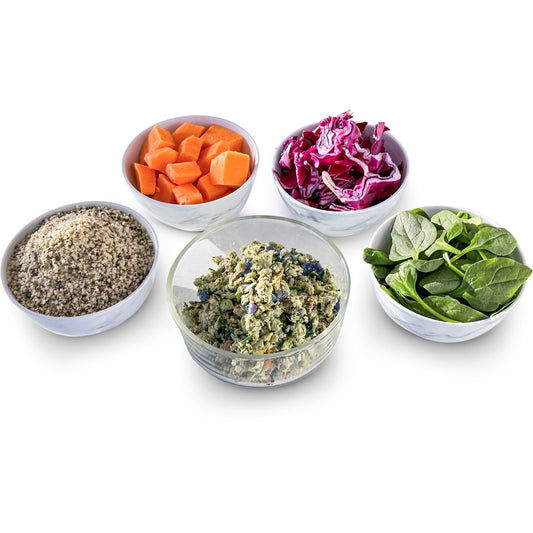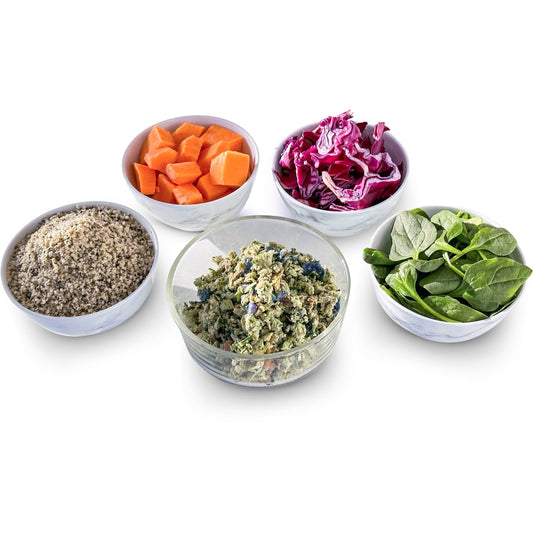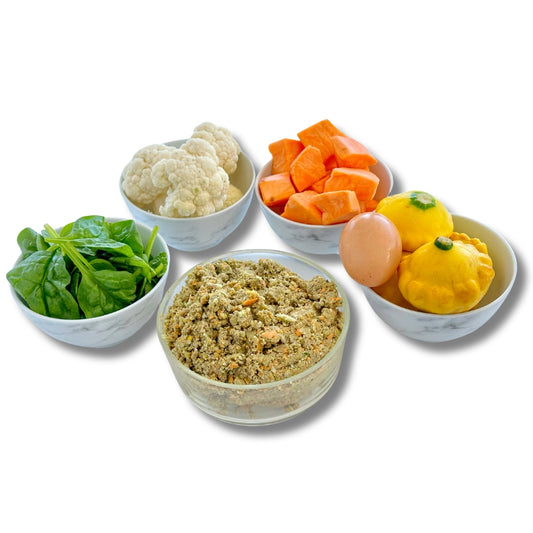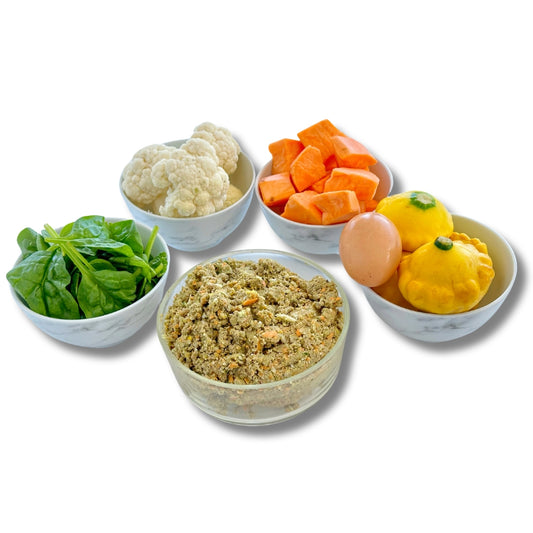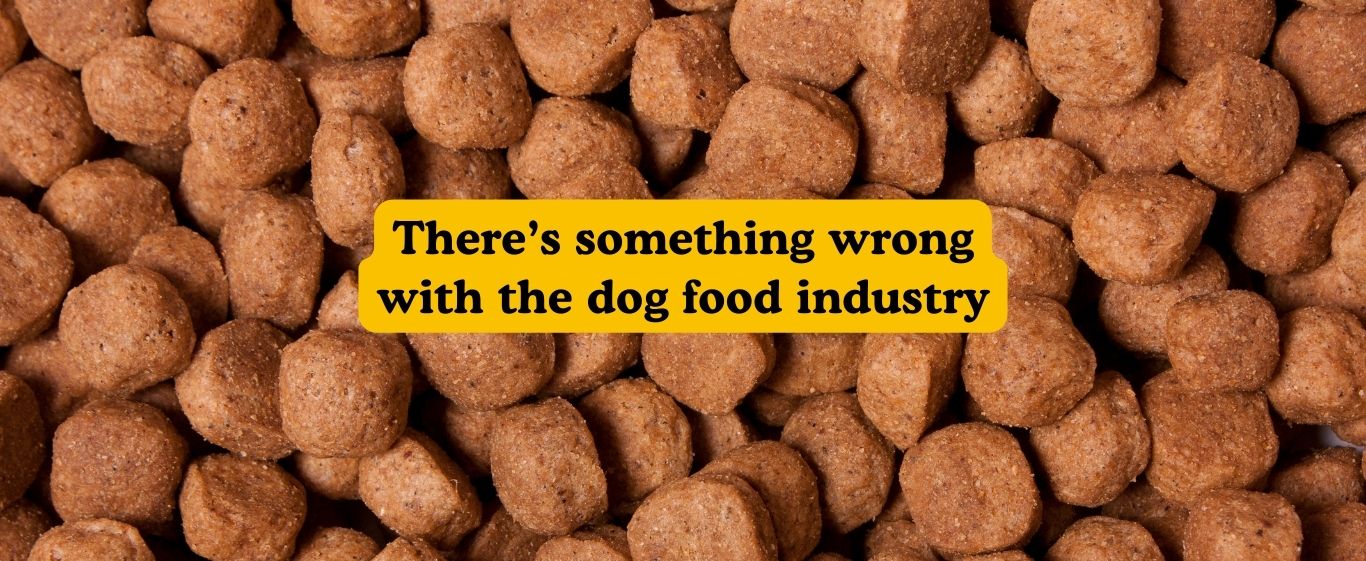
We’ve been trained to feed commercial supermarket “dog food.”
What do we have to show for it today?
In Australia, it is estimated that 25% of dogs will develop cancer at some point, and this increases to almost 50% of dogs over the age of 10. Over 33% of dogs are overweight, and of that, 8% are obese. And more than 80% of dogs develop some form of dental disease in their lifetime, surprising to most pet parents. Pet food production in Australia is held to alarmingly low safety and quality standards, which are hidden behind loose labeling and regulations.
5 things every dog parent should know
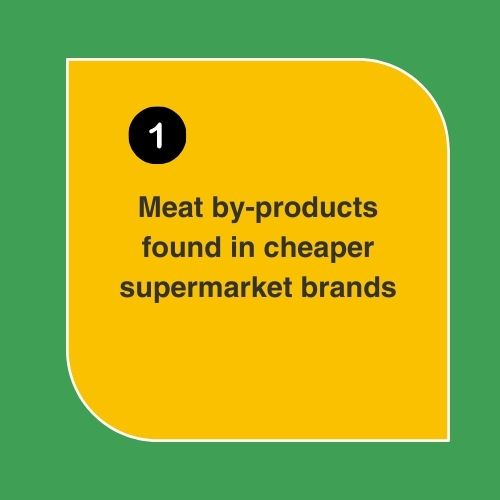
Meat by-products are common in cheaper supermarket brands, which are composed of rendered leftover animal parts. Instead of going to landfill, diseased meats are allowed in dog food if rendered at high heat (source: AAFCO). These by-products are generally not fit for human consumption, so why would we feed our dogs this?

Cooking wet and dry food using extreme high temperature vats results in significant vitamin and nutrient loss. Cooking at very high temperatures is known to produce carcinogens. Artificial preservatives are used to preserve dog food so it can sit on supermarket shelves for months and months.
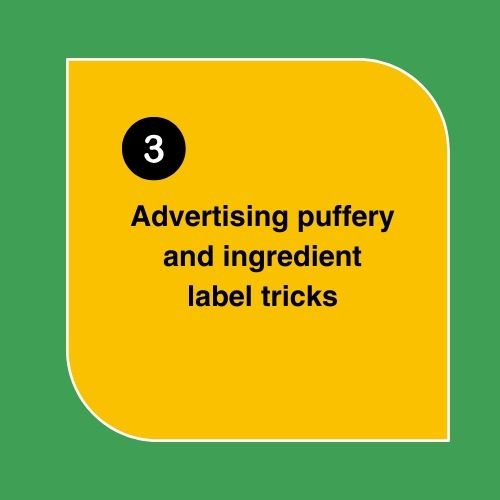
While the picture on the bag suggests that the brown ball inside was made with a beautiful chicken breast on a picturesque farm, the reality can instead be low quality by-product chicken leftover waste, mixed with grains, fillers and artificial preservatives.
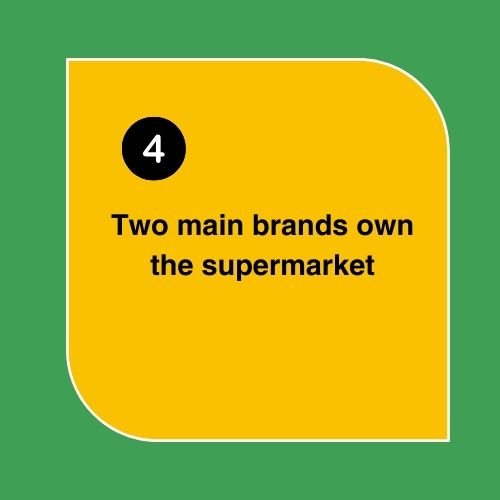
Mars and Nestle together own most of the brands on our supermarket shelves. Choice is a misconception. They train our vets, publish the research and own some of the vets. Read the packaging, understand the ingredients if you don’t want a candy company making your Fido’s food.
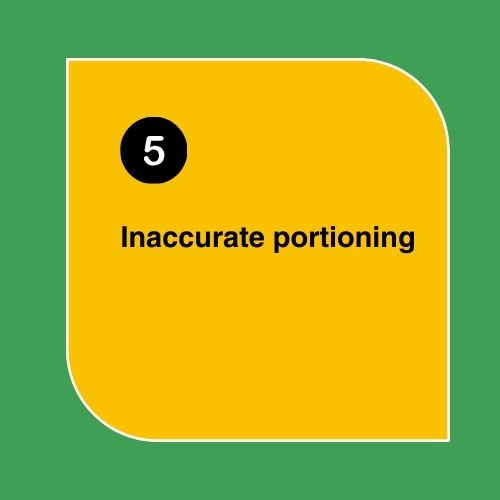
Obesity is the biggest health issue facing our dogs. According to research conducted by the RSPCA, 33.5% of dogs are overweight, and of that, 8% are obese. Feeding guidelines by pet food companies have conditioned us to over feeding with a one-size fits all approach.
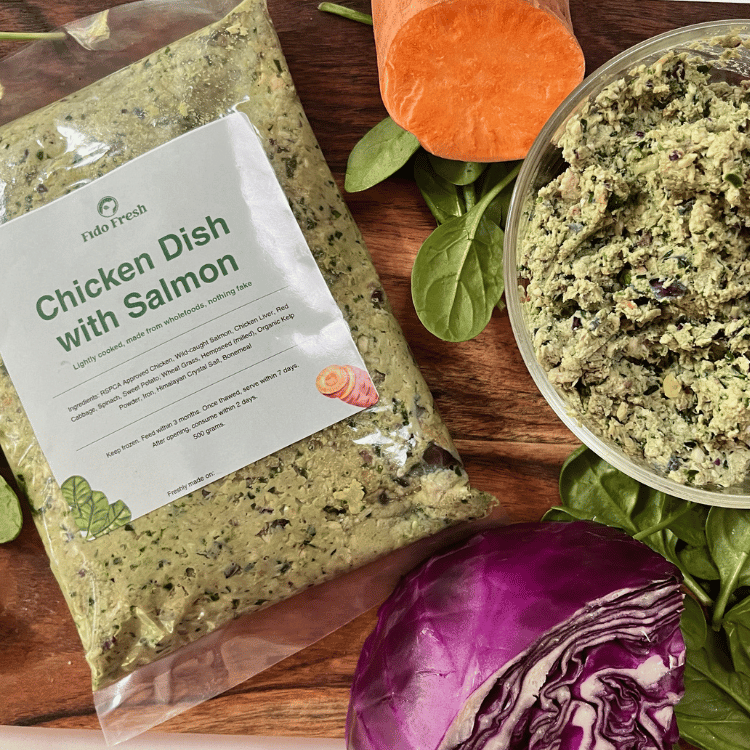
What's AAFCO and FEDIAF?
Complete and balanced dog food should follow AAFCO guidelines (American Pet Food Industry Guidelines) and/or FEDIAF guidelines (European Pet Food Industry Federation). These guidelines help ensure that the dog food you're feeding your Fido has undergone the appropriate analysis and has the necessary, required nutrients.
Fido Fresh recipes exceed both guidelines.
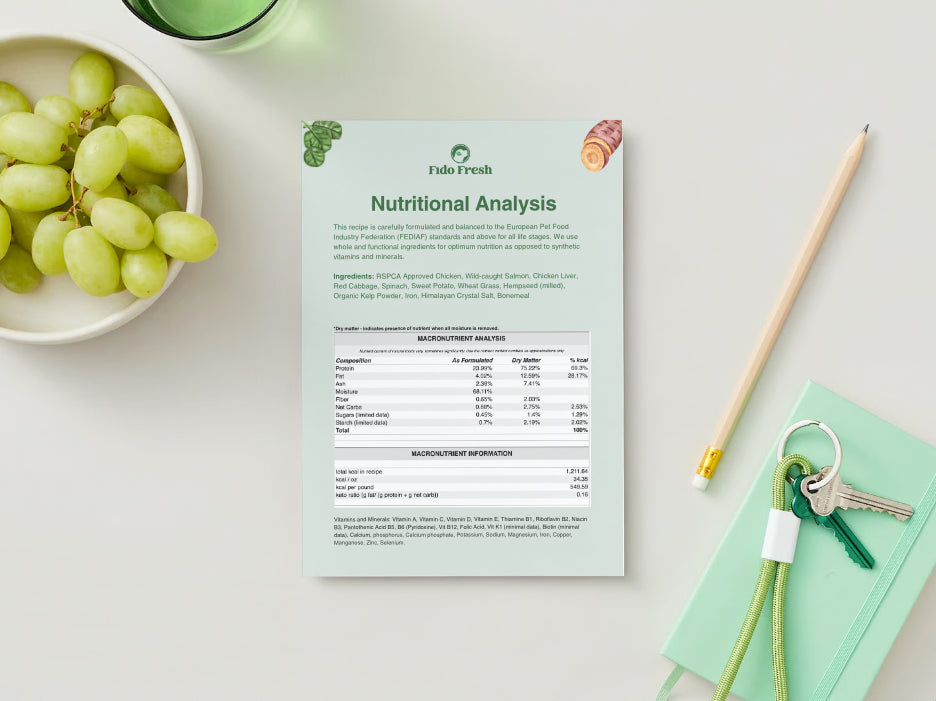
Nutritional Analysis
When buying food for your Fido, make sure AAFCO and/or FEDIAF Pet Food Industry Guidelines are clearly displayed, and the nutritional breakdown shown.
- Guaranteed Analysis - lists the percentage of each of the nutrients in the food.
- Nutritional Adequacy Statement - indicates that the food is complete and balanced for a particular life stage.
- Feeding Guidelines - indicates how much to feed your Fido. See our Feeding guidelines for our Chicken Dish with Salmon recipe here.
Fido Fresh Chicken Dish with Salmon Nutritional Analysis can be found here.
What Fido Fresh does differently
97% of Fido parents see their Fido's health improve with Fido Fresh
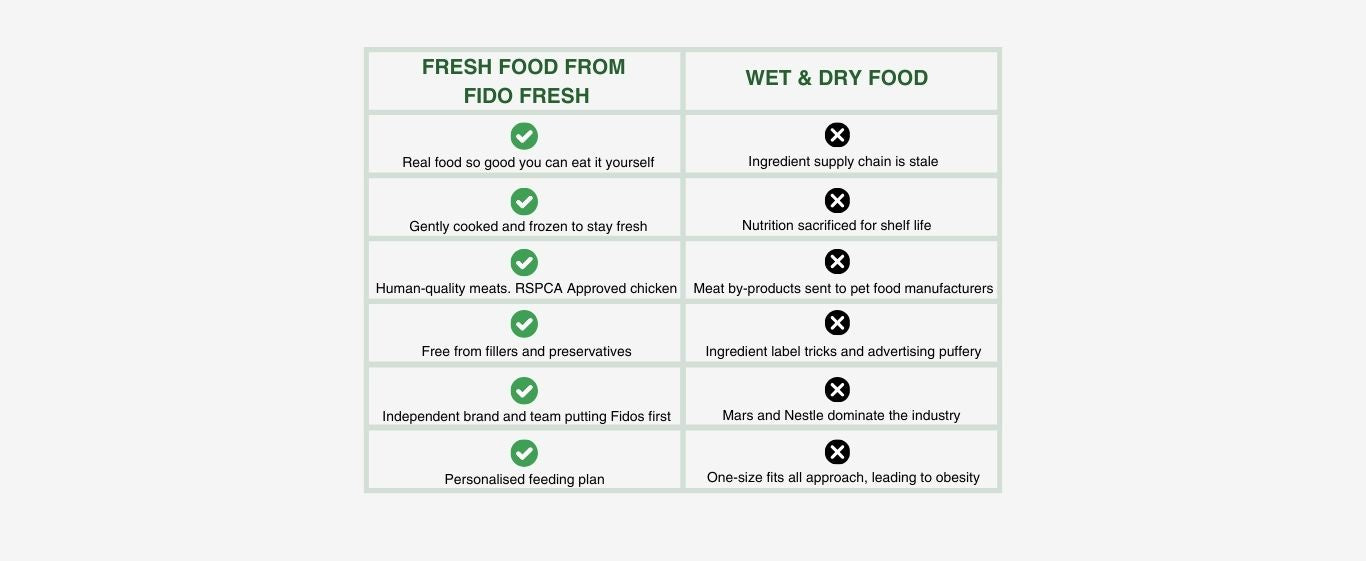

Quality human-grade ingredients you can see, and taste!
√ Ethically sourced, RSPCA Approved chicken and wild-caught salmon.
√ It goes beyond Fido's bowl, we care about all animals!
√ Our recipes are suitable for puppies, adults and senior dogs.
√ More tasty dishes to come soon!
The incredible health benefits
See our meals-

Better digestion, less stink in the garden
Human-grade ingredients, fresh and balanced recipes = less smell, less mess, less fuss.
-

More energy and playfulness
High in protein and nutritionally balanced recipes are Fidos best source of energy.
-

Shinier, healthier coat and less itching
Thanks to good fats and nutrients. Keeps Fidos healthy both inside and out.
-

Easy-to-maintain healthy weight
Personalised feeding guide gets Fidos to their healthy weight. No one-size fits all.
Unleashing health and happiness in every bite
-
Chicken Dish with Salmon - Starter Pack (3 Packs)
17 reviewsRegular price $39.95Regular priceUnit price / per -
Chicken Dish with Salmon (10 Packs)
5 reviewsRegular price $99.95Regular priceUnit price / per -
Beef Dish with Squash - Starter Pack (3 Packs)
1 reviewRegular price $39.95Regular priceUnit price / per -
Beef Dish with Squash (10 Packs)
No reviewsRegular price $99.95Regular priceUnit price / per
Let customers speak for us
from 28 reviewsA well-made product that both our dogs love.

The food from Fido Fresh is great quality and healthy. All my 3 dogs love it and it’s really easy as it gets delivered Iced and frozen right at my door step. Highly recommend! It’s better than feeding your dogs kibble.

Our boy loves his Fido fresh and we love the convenience. Highly recommended.

Hassan kindly let us have a sample pack and Pablo will now not even look at his old food! Thanks so much - let's hope he slims down with your amazing meals! Will be ordering shortly

Milo loves his Fido Fresh, great service and top quality!

I have two fussy poodles and so far they’ve been on Fido fresh for a month and are still loving it. I like the ease of having quality food for my dogs with real ingredients I can see and know are healthy for my dogs without having to make it myself and can see the benefits it is having on my dogs health and well being

Fabulous company with amazing customer service. My dog says the food itself is completely yummy!

Since adding Fido fresh to our 12 years olds diet we have seen a significant change in his mobility, coat and excitement at dinner time. A great local business we are so happy to support.

I fussy old girl
loved it !

Thank you Fido Fresh! Our sample was delivered within 2 hours of ordering. Our staffy is now eating better than us humans! Placing our first weekly order now! A1 customer service from Hassan and Natasha as well!

Love that the food is as fresh and healthy as human food.
Lion wolfs it down and looks for more!

My cavoodle is 2 1/2 and has been so fussy so glad I got my sample pack to try and she loved it straight away!!!!!







